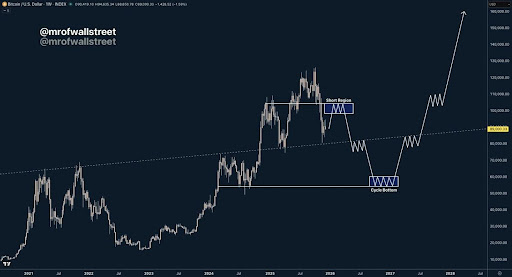Thomas Lee's Market Outlook: Navigating Tech Optimism and Strategic Sector Shifts in Q4 2025
- Thomas Lee, Fundstrat's top analyst, forecasts Q4 2025 tech growth via semiconductors/AI while shifting toward value/energy sectors. - His bullish stance on SOX and AVGO contrasts with hedging via small-cap (IWM) and inflation-linked ETFs (USAF) to balance market volatility. - Dovish Fed policy and Bitcoin's $100k milestone drive risk appetite, but Lee warns against overexposure to overvalued tech giants like Nvidia. - Investors urged to rebalance portfolios with GRNY's AI/cybersecurity focus and cyclica
In the ever-evolving landscape of financial markets, few voices carry the weight of Thomas J. Lee, Head of Research at Fundstrat Global Advisors. With a 25-year track record of top-tier equity research and a reputation for precision in forecasting, Lee's recent Q4 2025 outlook has sparked renewed interest among institutional and retail investors alike. While his bullish stance on the S&P 500 and tech-driven sectors like semiconductors and AI has been well-documented, a closer examination of his strategic pivot toward value and energy stocks reveals a nuanced approach to navigating market volatility and positioning for long-term resilience.
The Bullish Case for Tech Growth
Lee's optimism for the technology sector remains firmly intact. The Philadelphia Semiconductor Index (SOX), a bellwether for the industry, has shown signs of consolidation and breakout potential, with Lee highlighting its role as a key driver of market momentum. Semiconductors, particularly through companies like Broadcom (AVGO), have delivered robust returns in 2025, with AVGO up 20% year-to-date. His flagship ETF, the Granny Shots US Large Cap ETF (GRNY), further underscores this conviction, allocating to high-growth AI and cybersecurity stocks such as Palo Alto Networks and Live Nation Entertainment . GRNY's 16% return in 2025 has attracted $2.3 billion in assets, reflecting institutional confidence in these themes.
Lee's analysis also ties tech growth to macroeconomic catalysts. A dovish Federal Reserve, with rate cuts anticipated in December 2024 and early 2025, is expected to fuel risk appetite. Additionally, Bitcoin's breakout above $100,000—a milestone Lee has long anticipated—serves as a barometer for broader equity strength, signaling institutional adoption of digital assets as part of diversified portfolios.
Strategic Pivot to Value and Energy Stocks
While Lee's enthusiasm for tech remains undiminished, his recent commentary reveals a tactical shift toward value and energy sectors. This pivot is not a bearish turn on tech growth but rather a recognition of market dynamics that demand diversification. The Russell 2000 (IWM), a proxy for small-cap equities, has emerged as a leader in momentum-driven rotations, with Lee emphasizing its potential to outperform in a low-interest-rate environment.
Energy and industrial stocks, including Tesla and Eaton , are also gaining traction. Improved manufacturing data and a dovish Fed environment position these sectors to benefit from cyclical rebounds. Lee's advocacy for inflation-linked ETFs like the Atlas America Fund (USAF) further underscores his hedging strategy against macroeconomic uncertainties.
Implications for Investor Sentiment and Positioning
Lee's dual focus on growth and value sectors reflects a broader narrative of market resilience. The “perception gap” he highlights—between market expectations and reality—has narrowed as investors recalibrate to a post-pandemic landscape. For example, the muted impact of tariffs and the Fed's policy pivot have bolstered risk appetite, creating opportunities for strategic rebalancing.
However, this environment also demands vigilance. Lee cautions against overexposure to large-cap tech stocks like Nvidia and Palantir , which have experienced pullbacks after years of gains. These corrections, he argues, are natural and present buying opportunities for disciplined investors.
Urgency for Portfolio Reassessment
The urgency for investors to reassess their exposure lies in the interplay of macroeconomic clarity and sector-specific dislocations. Lee's emphasis on thematic ETFs and risk-parity strategies offers a framework for capitalizing on these shifts. For instance, the GRNY ETF's focus on AI and cybersecurity aligns with long-term trends, while allocations to small-cap and industrial stocks provide downside protection.
Conclusion: Balancing Growth and Resilience
Thomas Lee's Q4 2025 outlook is a masterclass in balancing optimism with pragmatism. While his bullish stance on tech growth remains intact, the strategic pivot toward value and energy sectors underscores the importance of diversification in a volatile market. For investors, the key takeaway is clear: reassess exposure to high-conviction sectors like semiconductors and AI, while hedging with value plays in small-cap and industrial equities. By aligning portfolios with Lee's macroeconomic clarity and sector-weighting expertise, investors can navigate the final quarter of 2025 with both confidence and agility.
In a market where perception often precedes reality, Lee's insights serve as a compass for those seeking to capitalize on emerging dislocations. As the Fed's policy trajectory and macroeconomic data unfold, the ability to adapt—without losing sight of long-term trends—will define the most successful investment strategies.
Disclaimer: The content of this article solely reflects the author's opinion and does not represent the platform in any capacity. This article is not intended to serve as a reference for making investment decisions.
You may also like
Quantum Computing Bitcoin: Michael Saylor’s Powerful Vision for an Unbreakable Future

1.18 Billion XRP In Four Weeks. Here’s What Whales Are Doing
PancakeSwap, YZi Labs Announce Zero-Fee Prediction Market on BNB Chain